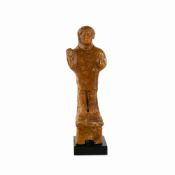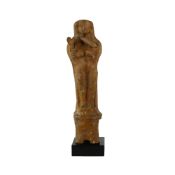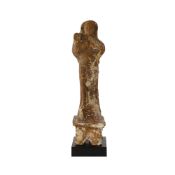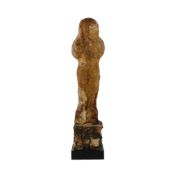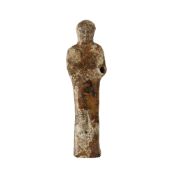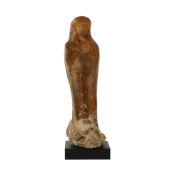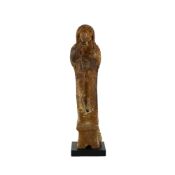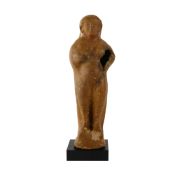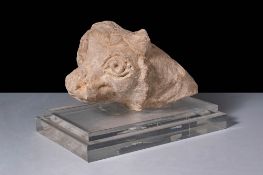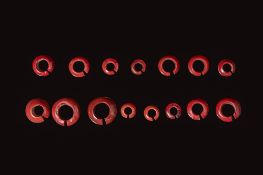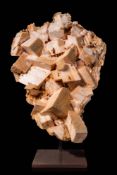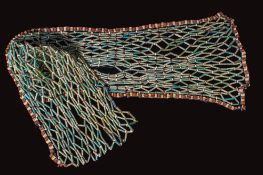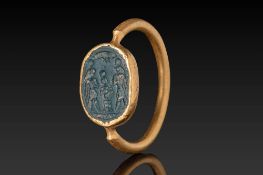Ca. 6th - 4th century BC A terracotta sculpture depicting a male figure dressed in a classical-style tunic and with a similarly styled coiffure. T...
- Startseite
- Suchergebnisse
*
Verfeinern Sie Ihre Suche
Schätzpreis
Auktionsort
Kategorie
- Spielzeug, Modelle & Puppen (12703)
- Varia (11705)
- Schmuck (11011)
- Gemälde & Mischtechniken (8510)
- Druckgrafiken & Multiples (4783)
- Waffen, Rüstungen & Militaria (4293)
- Porzellan (3341)
- China (3046)
- Skulpturen (3024)
- Bücher, Manuskripte & Schriften (2886)
- Möbel (2648)
- Zeichnungen & Pastelle (2164)
- Münzen (2059)
- Armbanduhren, Taschenuhren & Zubehör (2031)
- Silber & Versilbertes (1936)
- Keramik, Fayencen (1934)
- Griechische, Römische, Ägyptische & andere Antiquitäten (1891)
- Aquarelle (1306)
- Glas & Kristall (1189)
- Kunst (1179)
- Dekorative Kunst (942)
- Japan (910)
- Fotografie (862)
- Vintage Fashion (851)
- Teppiche & Läufer (825)
- Wein & Spirituosen (797)
- Ethnographie & Stammeskunst (772)
- Asiatische Kunst (716)
- Großuhren (702)
- Sport Memorabilia & Equipment (702)
- Briefmarken (589)
- Jugendstil & Art Déco (556)
- Musikinstrumente & Memorabilia (545)
- Lampen (529)
- Präparate & Naturkundliches (400)
- Metalle (388)
- Sakrales & Volkskunst (355)
- Historische Baustoffe & Elemente (314)
- Russische Kunst (199)
- Uhren, Armbanduhren, Taschenuhren & Schmuck (162)
- Islam (159)
- Design (155)
- Landkarten (143)
- Oldtimer, Motorräder & Automobile (129)
- Schreibgeräte (122)
- Küchenutensilien (104)
- Vintage Fashion & Textilien (99)
- Allgemeines Kollektiv (95)
- Kameras & Fotoausrüstungen (90)
- Indien (82)
- Wissenschaftliche Instrumente (81)
- Textilien (71)
- Unterhaltung Memorabilia (40)
- Eisenbahngeschichte (30)
- Werkzeug (25)
- Banknoten & Wertpapiere (18)
- Barometer (5)
- Kühlschränke (3)
Künstler / Marke
- Märklin (4732)
- Meissen (1293)
- Porcelain Makers & Brands (1136)
- Watch Brands (972)
- Roco-Modelleisenbahnen (571)
- Vintage Fashion Designers (483)
- Ceramics Manufacturers / Genre (440)
- Schuco (418)
- Qing (411)
- Qing Dynasty (411)
- Elastolin (369)
- Fleischmann (329)
- Rolex (322)
- Lineol (302)
- Roman (284)
- KPM (244)
- Star Wars (235)
- LGB garden railways (234)
- Meiji (232)
- Trix (217)
- Cartier (216)
- Royal Doulton (216)
- Oskar Kokoschka (215)
- Bing (203)
- Omega (202)
- Rosenthal (198)
- Chanel (194)
- Wiking (194)
- Meiji Period (185)
- Glassware Makers / Brands (180)
- Ming (180)
- Ming Dynasty (180)
- Louis Vuitton (179)
- Edo (175)
- Lima (153)
- Kangxi (152)
- Rudolf (152)
- Egon Schiele (147)
- Edo Period (139)
- Gustav Klimt (139)
- Western Asiatic (133)
- Song (128)
- Steiff (128)
- British School (123)
- Spirits Makers / Brands (121)
- Hornby (120)
- Pablo Picasso (117)
- Hermes (111)
- Karl Lagerfeld (110)
- England (107)
- Imari (105)
- Gama Toys (103)
- Palitoy (96)
- Chopard (94)
- Albrecht Dürer (93)
- Dresden (91)
- Kenner Products (88)
- Streichholzschachtel (87)
- Greek (85)
- Erich Heckel (84)
- Macallan (84)
- Nike (84)
- Tang (84)
- Tang Dynasty (84)
- Lehmann (83)
- Dent (82)
- Friedensreich Hundertwasser (80)
- Kandinsky (80)
- Murano (80)
- Han (79)
- Han Dynasty (79)
- Derby (78)
- Nymphenburg (78)
- Cecil Beaton (76)
- Royal Copenhagen (76)
- Tiffany & Co. (75)
- Speyside (74)
- Rembrandt (72)
- Tibetan (71)
- Bulgari (70)
- Egypt (67)
- Hummel (66)
- Paul Klee (66)
- Byzantine (64)
- Hiroshige (64)
- Otto Dix (61)
- Rivarossi (61)
- Siku (61)
- Wedgwood (61)
- Breitling (59)
- Dinky Toys (59)
- Deutsch (59)
- Heimo Zobernig (59)
- Victor Vasarely (59)
- Marc Chagall (58)
- Wassily Kandinsky (58)
- Ernst Ludwig Kirchner (54)
- St. Louis (53)
- royal crown (53)
- Craigellachie (52)
- Goethe (51)
- Delft (48)
- Emil Nolde (47)
- Gucci (47)
- Wempe (47)
- Ireland (46)
- Longines (46)
- Henri Matisse (45)
- English School (44)
- Heuer (44)
- Max Liebermann (44)
- Umbro (44)
- Sèvres (43)
- Andy Warhol (42)
- Bachmann (42)
- Adidas (41)
- Jouef (41)
- Kunisada (41)
- TAG Heuer (41)
- Zhou (41)
- Zhou Dynasty (41)
- Corgi (40)
- Peter Paul Rubens (40)
- Wilkens (40)
- Disney (39)
- Germany (39)
- Jaeger-LeCoultre (39)
- Pokemon (39)
- Tottenham Hotspur (39)
- Tudor (39)
- Karuizawa (38)
- Braun (36)
- IWC (36)
- Junghans (36)
- Limoges (36)
- Max Ernst (36)
- Patek Philippe (36)
- Arnulf Rainer (35)
- Van Cleef & Arpels (35)
- Bandai (34)
- Beswick (34)
- Breguet (34)
- Celtic (34)
- France (34)
- Glashütte (34)
- Lego (33)
- Guy Taplin (32)
- Lalique (32)
- Lovis Corinth (32)
- Technofix (32)
- Asmat (31)
- Gerhard Richter (31)
- Chikanobu Yoshu (30)
- Christian Dior (30)
- Classic Car & Vehicle Brands (30)
- Gallé (30)
- Joan Miró (30)
- Caliber (29)
- Fahrräder (29)
- George Grosz (29)
- Giovanni Battista Piranesi (29)
- Maria Lassnig (29)
- Sheffield United (29)
- Swarovski (29)
- Yoruba (29)
- Edvard Munch (28)
- Gottfried Helnwein (28)
- Liverpool (28)
- Staffordshire (28)
- August Gaul (27)
- Ivory Coast (27)
- Kammer & Reinhardt Puppen (27)
- MacPhail (27)
- Minichamps (27)
- Ptolemaic (27)
- Seiko (27)
- Viking (27)
- WMF (Württembergische Metallwarenfabrik AG) (27)
- Worcester (27)
- Alfred Kubin (26)
- Chelsea (26)
- Jaeger (26)
- Villeroy & Boch - Mettlach (26)
- Virginie Viard (26)
- Akan (25)
- Albert Reuss (25)
- Fabergé (25)
- Georg Jensen (25)
- Kathe Kruse (25)
- Luristan (25)
- Maiolica (25)
- Majolika (25)
- Max Beckmann (25)
- Uefa (25)
- Anthony Van Dyck (24)
- Cleef and Arpels (24)
- Continental School (24)
- Goebel Porzellan (24)
- Italian School (24)
- Salvador Dali (24)
- Salvador Dalí (24)
- Simon & Halbig (24)
- Waterford Crystal (24)
- West Ham (24)
- Willem Van De Velde (24)
- Christo (23)
- French School (23)
- Moorcroft (23)
- Atlas (22)
- Conrad Felixmüller (22)
- Franz West (22)
- West Ham United (22)
- Canada (21)
- Daum (21)
- Dayak (21)
- Glenlivet (21)
- Goya (21)
- Lladro (21)
- Max Pechstein (21)
- Rado (21)
- Vienna (21)
- villeroy (21)
- Gerhard Marcks (20)
- Isfahan (20)
- Longquan Celadon (20)
- Maurice Lacroix (20)
- Piaget (20)
- Rembrandt Van Rijn (20)
- Roy Lichtenstein (20)
- Sonia Delaunay (20)
- Taisho (20)
- Utagawa Kunisada (20)
- Zenith (20)
- Heubach (19)
- Käthe Kruse (19)
- Lyonel Feininger (19)
- Mainline (19)
- Mettoy Playcraft (19)
- Otto Piene (19)
- Tissot (19)
- Vincent Van Gogh (19)
- Audemars Piguet (18)
- Baccarat (18)
- Bactrian (18)
- Corning (18)
- Dieter Roth (18)
- Dogon (18)
- Ebel (18)
- Erwin Wurm (18)
- FIFA (18)
- Gillow (18)
- Hasbro (18)
- Mesopotamian (18)
- Pierre Soulages (18)
- Pierre-Auguste Renoir (18)
- Pipilotti Rist (18)
- Second World War (18)
- Utagawa Hiroshige (18)
- Wallendorf (18)
- André Derain (17)
- Baseball (17)
- Bauer (17)
- Joseph Beuys (17)
- Knoll (17)
- Mappin & Webb (17)
- Marx Züge (17)
- Scotland (17)
- Showa (17)
- The Beatles (17)
- Tiffany Studios (17)
- Wine Makers / Brands (17)
- Armand (16)
- Armand Marseille Dolls (16)
- Babylonian (16)
- Baume & Mercier (16)
- Charles (16)
- Christofle (16)
- Dutch School (16)
- Franz Kafka (16)
- Gillows (16)
- Honda (16)
- Italy (16)
- Kashan (16)
- Manchester United (16)
- Ottoman (16)
- Qajar (16)
- Raymond Weil (16)
- Tongzhi Porcelain (16)
- Val Saint Lambert (16)
- Asian (15)
- China (15)
- Columbia (15)
- Dublo (15)
- Elamite (15)
- Flemish School (15)
- Frankenthal (15)
- Guinea (15)
- Hans Arp (15)
- Karl Schmidt-Rottluff (15)
- Lladró (15)
- Lotto (15)
- Lucio Fontana (15)
- St Louis (15)
- Royal Worcester (15)
- Amlash (14)
- Dunhill (14)
- G Plan (14)
- Georges Braque (14)
- Herman Miller (14)
- Niger (14)
- Prada (14)
- Rodin (14)
- Royal Navy (14)
- Showa Period (14)
- Solido (14)
- The Rolling Stones (14)
- Villeroy and Boch (14)
- Wembley (14)
- Émile Gallé (14)
- Alexander Calder (13)
- Alfred Stieglitz (13)
- Aristide Maillol (13)
- Bakongo (13)
- Baume and Mercier (13)
- Bburago (13)
- Betsey Johnson (13)
- Boucheron (13)
- Girard-Perregaux (13)
- Heritage (13)
- Katharina Grosse (13)
- Kosta Boda (13)
- Kurt Schwitters (13)
- Ludwigsburg (13)
- Man Ray (13)
- Martell (13)
- Meccano (13)
- Royal Copenhagen (13)
- Shang (13)
- Triang (13)
- Vacheron-Constantin (13)
- Valjoux (13)
- Archibald Thorburn (12)
- Banksy (12)
- Blancpain (12)
- Bow (12)
- Bulova (12)
- Busch (12)
- Citizen (12)
- Decca Records (12)
- Delvaux (12)
- Dom Pérignon (12)
- Dugena (12)
- Edward Steichen (12)
- Ernst Barlach (12)
- Goldsmiths Company (12)
- Henry Moore (12)
- Jean Michel Basquiat (12)
- Jean-Michel Basquiat (12)
- Joan Miro (12)
- Joshua Reynolds (12)
- Kosta (12)
- Latour (12)
- MTH Elektrische Züge (12)
- Manchester City (12)
- Marvel (12)
- Mettlach (12)
- Olympics (12)
- Picasso (12)
- Pierre Alechinsky (12)
- Pieter Bruegel (12)
- Senufo (12)
- Thomas Mann (12)
- Venini (12)
- YES (12)
- Baoulé (11)
- Britains (11)
- Celine (11)
- Dan (11)
- Eug�ne Verboeckhoven (11)
- Fendi (11)
- Fulham (11)
- Guido Reni (11)
- Hermann Hesse (11)
- Hibiki (11)
- Hiroshi Yoshida (11)
- Jean Cocteau (11)
- Jr (11)
- Kato Precision Railroad Models (11)
- Louis Jadot (11)
- Maisto (11)
- Moser (11)
- Phoebe Philo (11)
- Sasanian (11)
- Seguso (11)
- The Goldsmiths & Silversmiths Company Ltd (11)
- Titan (11)
- Toulouse Lautrec (11)
- Turkmen (11)
- Yquem (11)
- A. Lange & Söhne (10)
- Ardbeg (10)
- Asprey of London (10)
- Auguste Rodin (10)
- Boodles (10)
- Boss (10)
- Burleigh (10)
- Burleigh Ware (10)
- Chad Valley (10)
- Clarice Cliff (10)
- Ercol (10)
- Everton (10)
- Giorgio De Chirico (10)
- Hendrick Goltzius (10)
- Herbert List (10)
- Iznik (10)
- John Duncan Fergusson (10)
- John Galliano (10)
- Karl Schmidt Rottluff (10)
- Meiji Era (10)
- Paya (10)
- Pichon Lalande (10)
- Robert Rauschenberg (10)
- Sheffield Wednesday (10)
- Spain (10)
- Thonet (10)
- Valie Export (10)
- Venetian School (10)
- Zao Wou Ki (10)
- Archimede Seguso (9)
- Bauhaus (9)
- Benin (9)
- Canaletto (9)
- Certina (9)
- Charles & Ray Eames (9)
- Eames (9)
- Ernst Gerhard (9)
- First World War (9)
- Franklin (9)
- Georg Baselitz (9)
- Georg Kolbe (9)
- German School (9)
- Guercino (9)
- Gübelin (9)
- Horst P. Horst (9)
- Karel Appel (9)
- Limoges Porcelain (9)
- Lionel (9)
- Lombard School (9)
- Miuccia Prada (9)
- Neapolitan School (9)
- Paul Signac (9)
- Polaroid (9)
- Ruhla (9)
- Rémy Martin (9)
- Senegal (9)
- Sigmar Polke (9)
- Sitzendorf (9)
- Status Quo (9)
- Ulysse Nardin (9)
- Versace (9)
- Virgil Abloh (9)
- Waltham (9)
- Yves Klein (9)
- Abelam (8)
- Arsenal (8)
- Asprey (8)
- Aston Villa (8)
- Automobilia Brands (8)
- Bamana (8)
- Bartolomé Esteban Murillo (8)
- Bucherer (8)
- Cassina (8)
- Cyprus (8)
- César Baldaccini (8)
- David Bowie (8)
- David Teniers (8)
- Deep Purple (8)
- Eterna (8)
- Franck Muller (8)
- Franklin Mint (8)
- Herend (8)
- Hot Wheels (8)
- Jaeger-LeCoultre (8)
- Japy Frères (8)
- Josef Albers (8)
- Jules Pascin (8)
- Kestner Puppen (8)
- Kodak (8)
- L S Lowry (8)
- Lenox (8)
- Lesney Products & Co. (8)
- Maurice De Vlaminck (8)
- Meister (8)
- Mel Ramos (8)
- Montblanc (8)
- Nan Goldin (8)
- Newcastle United (8)
- Port Ellen (8)
- Qum (8)
- Ralph Lauren (8)
- Richard Serra (8)
- Singer (8)
- Sony (8)
- Southampton (8)
- Switzerland (8)
- Tek Sing (8)
- The Who (8)
- Verge (8)
- Wedgwood - Jasperware (8)
- Wellendorff (8)
- Wilesco (8)
- Willem De Kooning (8)
- Willi Baumeister (8)
- Zeiss (8)
- Airfix (7)
- Annibale Carracci (7)
- Antoni Tàpies (7)
- Arman (7)
- August Sander (7)
- Bing and Gröndahl (7)
- Bowmore (7)
- C. J. Vander Ltd (7)
- Canon (7)
- Chateau Mouton Rothschild (7)
- Chiltern Spielzeuge (7)
- Christopher Dresser (7)
- David Hockney (7)
- Delftware (7)
- Eero Saarinen (7)
- Elkington & Co (7)
- Elsa Peretti (7)
- Emporio Armani (7)
- Enicar (7)
- Ettore Sottsass (7)
- Francesco Albani (7)
- Frans Hals (7)
- Garrard (7)
- Greece (7)
- Grima (7)
- Hermann Dittrich (7)
- Hokusai (7)
- Hong Kong (7)
- J. K. Farnell (7)
- Jacques Callot (7)
- James Ensor (7)
- Jean-Baptiste-Camille Corot (7)
- Jim Dine (7)
- John Bellany (7)
- L.S. Lowry (7)
- Laurence Stephen Lowry (7)
- Le Corbusier (7)
- Lenci (7)
- Lewis Carroll (7)
- Lucas Cranach The Elder (7)
- Macron (7)
- Maurice Denis (7)
- Maurice Utrillo (7)
- Mimmo Rotella (7)
- Omar Ramsden (7)
- Otto Steinert (7)
- Pandora (7)
- Parker (7)
- Pomellato (7)
- Qin (7)
- Richard Mille (7)
- Roman School (7)
- Ronald Ossory Dunlop (7)
- Saint Laurent (7)
- Shang Dynasty (7)
- Spode (7)
- Swatch (7)
- US (7)
- Vivienne (7)
- Wales (7)
- Waterman (7)
- William Shakespeare (7)
- Yves Saint Laurent (7)
- Alberto Giacometti (6)
- Albion (6)
- Alpha (6)
- Athearn Trains (6)
- Aubusson (6)
- Baccarat Crystal (6)
- Balinese (6)
- Bernd & Hilla Becher (6)
- Blackburn Rovers (6)
- Brazil (6)
- Camel (6)
- Camille Pissarro (6)
- Carlton (6)
- Carlton Ware (6)
- Chippendale (6)
- Château d Yquem (6)
- Claude Monet (6)
- Columbia Records (6)
- Coro (6)
- Corum (6)
- Cos d'Estournel (6)
- Crown Ducal (6)
- Crystal Palace (6)
- David Webb (6)
- Davis (6)
- Domaine Leflaive (6)
- Edgar Degas (6)
- Edwin Scharff (6)
- Elettren (6)
- Elvis Presley (6)
- Favre Leuba (6)
- Ferrari (6)
- George Romney (6)
- Glashütte Original (6)
- Hans Hartung (6)
- Haviland (6)
- Henri Boillot (6)
- Horikawa (6)
- James Abbott Mcneill Whistler (6)
- Karl Friedrich (6)
- Keith Haring (6)
- Kuba (6)
- Land Rover (6)
- Leeds United (6)
- Majorette (6)
- Marc Jacobs (6)
- Marino Marini (6)
- Markus Oehlen (6)
- Mattel (6)
- Odilon Redon (6)
- Peter Lely (6)
- Philips Wouwerman (6)
- Piero Dorazio (6)
- Pioneer (6)
- RAF (6)
- Robert Jacobsen (6)
- Rotary (6)
- Royal Crown Derby (6)
- Salvatore Ferragamo (6)
- Stag's Leap Wine Cellars (6)
- Tonka (6)
- Trifari (6)
- Vitesse (6)
- Wade (6)
- Will McBride (6)
- Wrenn Model Railways (6)
- ZentRa (6)
- Shelley (6)
- vincennes (6)
- ACE Bahnen (5)
- Accurist (5)
- Albert Marquet (5)
- Albert Renger-Patzsch (5)
- Barbie (5)
- Bell & Ross (5)
- Bolton Wanderers (5)
- Bottega Veneta (5)
- Brocot & Delettrez (5)
- Bulgaria (5)
- Børge Mogensen (5)
- Chateau Margaux (5)
- Chateau de Puligny Montrachet (5)
- Chawner & Co (5)
- Chevalier Montrachet (5)
- Classique (5)
- Coalport Porcelain (5)
- Cote Rotie (5)
- Crown Devon (5)
- De Chirico (5)
- Delma (5)
- Derby County (5)
- Eduardo Chillida (5)
- Edward Barnard & Sons Ltd (5)
- Elisabeth Vigee Le Brun (5)
- Elton John (5)
- Enfield (5)
- Ethiopia (5)
- Faberge (5)
- Fernand Leger (5)
- Fon (5)
- Fritz Wotruba (5)
- George Adams (5)
- Georges Rouault (5)
- Georges Seurat (5)
- Graham (5)
- Greg Gorman (5)
- Hungary (5)
- Ipswich Town (5)
- Jacques Courtois (5)
- Jaeger Le Coultre (5)
- John Carter (5)
- John Lennon (5)
- Jun Ware (5)
- Katsushika Hokusai (5)
- Krug (5)
- Kusakabe Kimbei (5)
- Leni Riefenstahl (5)
- Liechtenstein (5)
- Lledo (5)
- Loetz (5)
- Lomonosov (5)
- Louis Majorelle (5)
- Milo Baughman (5)
- Minton Hollins (5)
- Movado (5)
- New Zealand (5)
- Niki De Saint Phalle (5)
- Norwich City (5)
- Pele (5)
- Pierre-Jules Mene (5)
- Pink Floyd (5)
- Rolleiflex (5)
- Royal Albert (5)
- Royal Worcester (5)
- Saint Louis (5)
- Samson (5)
- Scottish School (5)
- Sheraton (5)
- Spanish Oak (5)
- Straße (5)
- Sui (5)
- Takashi Murakami (5)
- The Nikka Whisky Distilling Co (5)
- Tobia Scarpa (5)
- Tom Wesselmann (5)
- Utagawa Kuniteru (5)
- Wilhelm von Gloeden (5)
- William Gear (5)
- Zwiesel (5)
- Adie Brothers (4)
- Alpina (4)
- Andrea del Sarto (4)
- Ashanti (4)
- Australia (4)
- Austria (4)
- Balenciaga (4)
- Bamileke (4)
- Ben Nevis (4)
- Benrus (4)
- Biondi Santi (4)
- Blackpool (4)
- Bob Dylan (4)
- Brentford (4)
- Cardfight Vanguard (4)
- Carl Zeiss (4)
- Chambolle (4)
- Charlotte Perriand (4)
- Chelsea Porcelain (4)
- Chokwe (4)
- Chronoswiss (4)
- Claire Colinet (4)
- Claude Lorrain (4)
- Clichy (4)
- Courvoisier (4)
- Cy Twombly (4)
- Dalmore (4)
- Damien Hirst (4)
- Dapol (4)
- Dieter Appelt (4)
- Dupont (4)
- Elgin (4)
- Ellsworth Kelly (4)
- Emilian School (4)
- Felice A. Beato (4)
- Fope (4)
- Francis Bacon (4)
- Frank Stella (4)
- Frankie & Heidecke (4)
- Frans Floris (4)
- Franz Kline (4)
- Gaspard Dughet (4)
- Georg Herold (4)
- George Nelson (4)
- Giambologna (4)
- Giorgio Sommer (4)
- Glenfiddich (4)
- Globe Wernicke (4)
- Goldscheider (4)
- Grace Hartigan (4)
- Graham Sutherland (4)
- Grant (4)
- Guernsey (4)
- Guro (4)
- Günther Uecker (4)
- HMT (4)
- HMV (4)
- Hamilton (4)
- Heian Period (4)
- Helmut Newton (4)
- Henry Raeburn (4)
- Hepplewhite (4)
- Highland Park (4)
- Holmegaard (4)
- Horst Antes (4)
- Jackson Pollock (4)
- James Dixon & Sons (4)
- James Nachtwey (4)
- Japan (4)
- Jasper Johns (4)
- Jean Tinguely (4)
- Joan Hernández Pijuan (4)
- Joan Mitchell (4)
- Johan Rohde (4)
- John Singer Sargent (4)
- Kate Spade New York (4)
- Kitagawa Utamaro (4)
- Knockdhu (4)
- Laco (4)
- Lafite Rothschild (4)
- Lange and Söhne (4)
- Le Roy (4)
- Leica (4)
- Leicester City (4)
- Liao Dynasty (4)
- Louis Roederer (4)
- Luba (4)
- Lucas Cranach (4)
- Lucian Freud (4)
- Marcel Breuer (4)
- Marcel Duchamp (4)
- Mario Giacomelli (4)
- Marques de Murrieta (4)
- Mauser (4)
- Merrythought (4)
- Metalware Manufacturers / Brands (4)
- Minolta (4)
- Mitre (4)
- Mongo (4)
- Moët & Chandon (4)
- Muromachi Period (4)
- Mühle Glashütte (4)
- Mühle-Glashütte (4)
- Nautilus (4)
- Neil Wilkin (4)
- Noritake (4)
- Oris (4)
- Orrefors glassworks (4)
- Parthian (4)
- Paul Gauguin (4)
- Paul McCartney (4)
- Pende (4)
- Pierre Bonnard (4)
- Poljot (4)
- Qingbai Ware (4)
- Raoul Dufy (4)
- Republic of Ireland (4)
- Richard Pare (4)
- Richard Riemerschmid (4)
- Rirkrit Tiravanija (4)
- Robbe and Berking (4)
- Robert Adam (4)
- Roberto Matta (4)
- Rover (4)
- Safavid (4)
- San (4)
- Sebastian Munster (4)
- Serge Poliakoff (4)
- Sevres (4)
- Sibylle Bergemann (4)
- Sigma (4)
- Stephen Shore (4)
- Taittinger (4)
- Tillig (4)
- Timex (4)
- Titian (4)
- United States (4)
- Utagawa Kuniyoshi (4)
- Valentin Eisch (4)
- Victor Mayer (4)
- Walthers (4)
- Wassily (4)
- Weegee (4)
- Wemyss Ware (4)
- West Bromwich Albion (4)
- Whitefriars (4)
- William Bateman (4)
- William Russell Flint (4)
- Zippo (4)
- Abbasid (3)
- Abraham Hulk (3)
- Ace of Spades (3)
- Ai Weiwei (3)
- Alice Neel (3)
- Andorra (3)
- Andreas Feininger (3)
- André Masson (3)
- Anton Corbijn (3)
- Antoni Tapies (3)
- Argentina (3)
- Aristo-Craft (3)
- Arnaldo Pomodoro (3)
- Arran (3)
- Asante (3)
- Atlantic Records (3)
- Augustus John (3)
- Austral Islands (3)
- Austrian School (3)
- Avia (3)
- Ayyubid (3)
- Bakuba (3)
- Balvenie (3)
- Baron Raimund von Stillfried (3)
- Belgium (3)
- Bell and Ross (3)
- Bergmann (3)
- Bjørn Wiinblad (3)
- Blaeu (3)
- Bolognese School (3)
- Bonneau Du Martray (3)
- Bonnes Mares (3)
- Boodle & Dunthorne (3)
- Bugatti (3)
- Buler (3)
- Buren (3)
- Capodimonte Porcelain (3)
- Carl Andre (3)
- Carlo Bugatti (3)
- Ceylon (3)
- Charles Adam (3)
- Charles Lancaster (3)
- Charles Reily (3)
- Chateau La Mission Haut Brion (3)
- Chateau d'Yquem (3)
- Chile (3)
- Claude Lalanne (3)
- Cliff Richard (3)
- Coach (3)
- Congo (3)
- Corneille (3)
- Czechoslovakia (3)
- Daum Frères (3)
- David Reekie (3)
- David Shrigley (3)
- De Grisogono (3)
- Deep Blue (3)
- Denmark (3)
- Diane Arbus (3)
- Diego Velázquez (3)
- Doccia (3)
- Du Bois (3)
- E Viner (3)
- Edgar Hunt (3)
- Egger Bahn (3)
- Elliot Offner (3)
- Eugène Atget (3)
- Eugène Boudin (3)
- Fatimid (3)
- Fleetwood (3)
- Francesco Bartolozzi (3)
- Francesco Guardi (3)
- Francesco Zuccarelli (3)
- Francis Picabia (3)
- Friedrich (3)
- Fritware (3)
- Fritz Stattler (3)
- Fulvio Bianconi (3)
- George Best (3)
- George Hurrell (3)
- George Unite (3)
- German States (3)
- Giovanni Battista Piazzetta (3)
- Givenchy (3)
- Glenmorangie (3)
- Great Britain (3)
- Gruen (3)
- Guild of Handicraft (3)
- Gustav Naujok (3)
- Gustavsberg (3)
- H.J. Wegner (3)
- Hans Bellmer (3)
- Hans Hansen (3)
- Hans Holbein (3)
- Harris Lebus (3)
- Heinz Hajek-Halke (3)
- Hennessy (3)
- Henri Rousseau (3)
- Henry Cooper (3)
- Hieronymus Bosch (3)
- Hohner (3)
- Hublot (3)
- Hukin & Heath (3)
- Invicta (3)
- Irving Penn (3)
- Jacob (3)
- Jacopo Bassano (3)
- Jean-Auguste-Dominique Ingres (3)
- Jesús Rafael Soto (3)
- Jimi Hendrix (3)
- Johann Baptist Homann (3)
- John Baldessari (3)
- John Craxton (3)
- John Emes (3)
- John Nash (3)
- John Piper (3)
- John Scofield (3)
- John Varley (3)
- Joseph Csaky (3)
- Joseph Willmore (3)
- Joseph Wright of Derby (3)
- Jules Moigniez (3)
- Karlsruher Majolika (3)
- Kees Van Dongen (3)
- Kienzle (3)
Auktionstyp
Land
Auktionshaus
- AaG Auktionshaus am Grunewald GmbH (3)
- ACA-Auctions (250)
- anticomondo GmbH (1922)
- Antik Vegesack GmbH & Co.KG (893)
- Antiqon (316)
- Apollo Art Auctions (909)
- Auctioneum Ltd - East Bristol & Bath (1634)
- Auktionshalle Cuxhaven GBR (1134)
- Auktionshaus C. Semprich (186)
- Auktionshaus City Nord im Hause Dr. Greve GmbH (1239)
- Auktionshaus Groben (387)
- Auktionshaus Heickmann (2494)
- Auktionshaus im Kinsky (372)
- Auktionshaus Karrenbauer (762)
- Auktionshaus Kloss (410)
- Auktionshaus Ludwigsburg BENE MERENTI GmbH (1293)
- Auktionshaus Lux (1704)
- Auktionshaus Mehlis (3568)
- Auktionshaus Rapp (583)
- Auktionshaus Regele (161)
- Auktionshaus Saarbrücken GmbH (803)
- Auktionshaus Schramm (719)
- Auktionshaus Stahl GmbH & Co. KG (707)
- Auktionshaus von Brühl (285)
- Auktionshaus VS GmbH (1)
- Auktionshaus Weidler (719)
- Auktionshaus Weser (1505)
- Blenheim Auctions (404)
- Bonhams (5125)
- Bozner Kunstauktionen (546)
- C & T Auctioneers and Valuers Ltd - Live (307)
- Cabral Moncada Leilões (10)
- Cadmore Auctions Ltd (411)
- Carlo Bonte Auctions (869)
- Christian Hesse Auktionen (634)
- DAWO Auktionen (805)
- Dr. Reinhard Fischer (1)
- Dresdener Kunstauktionshaus Günther (718)
- Dreweatts 1759 (1941)
- Düsseldorfer Auktionshaus (1717)
- Eastbourne Auctions (2907)
- Einszwei Gallery (561)
- Elmwood's (550)
- Eppli Auktionshalle (323)
- Eppli Auktionshaus (85)
- Eppli Münzhandel & Auktionen (244)
- Etrusca Auctions Ltd (331)
- Fiveways Assets Limited (518)
- Gailer Kunstauktionshaus am Chiemsee (713)
- Galerie Bassenge (2596)
- Graham Budd Auctions Ltd (531)
- GRISEBACH GmbH (508)
- H&F International Limited (684)
- Hatton Garden Auctions Ltd (402)
- Henry's Auktionshaus (1621)
- Humbert & Ellis Ltd (10)
- Jeschke Jádi Auctions Berlin GmbH (938)
- JG Auction (300)
- Karl & Faber Kunstauktionen GmbH (344)
- Karl-Heinz Cortrie GmbH (370)
- Kendzia Auktionen (1551)
- Ketterer Kunst Hamburg (348)
- Kunstauktionshaus Schloss Ahlden GmbH (1320)
- Leininger Auktionshaus (1791)
- Lempertz Köln (713)
- Lion and Unicorn (1900)
- Lucas Aste (559)
- Mayfair Auctions (275)
- Militaria Auctions (1)
- Münchner Spielzeugauktion (2053)
- NCM Auctions (98)
- Oriental Art Auctions (310)
- Ostantix Auctions (1000)
- Phixius Auctions (134)
- Potteries Auctions (316)
- Ressler Kunst Auktionen GmbH (211)
- Revere Auctions (1061)
- Schätze schätzen FlexKapG (335)
- Scheublein Art & Auktionen KG (825)
- Schmidt Kunstauktionen Dresden OHG (659)
- Stade Auktionen GmbH & Co. KG (6293)
- Sterling Vault Auctioneers (307)
- Templum Fine Art Auctions (1)
- TimeLine Auctions Limited (3879)
- Unicart s.r.l (186)
- VAN HAM Kunstauktionen (562)
- Veilinggebouw de Zwaan (2942)
- Veilinghuis de Jager (1855)
- Von der Warth und Lankes GmbH & Co. KG (2271)
- Von Zengen Kunstauktionen GmbH & Co. KG (2333)
- Wannenes Art Auctions (218)
- WETTMANN | Auktionshaus an der Ruhr (592)
- Widder Auktionen (583)
- Woolley & Wallis (657)
- Wormser Auktionshaus (6084)
- Liste
- Galerie
-
97206 Los(e)/Seite
Ca. 6th century BC A sculpture of a man dressed in a classical tunic and wearing a classical hairstyle. This terracotta belongs to a group of Phoe...
Ca. 5th - 4th century BC A terracotta sculpture representing a woman, possibly a goddess. The sculpture forms part of a group of Phoenician terrac...
Ca. 6th - 4th century BC A terracotta sculpture representing a female deity, most likely assimilated to the goddess Astarte, protector of the hous...
Ca. 6th - 4th century BC A terracotta sculpture depicting a female figure dressed in a classical-style tunic and with a similarly styled coiffure....
Ca. 7th - 6th century BC A terracotta sculpture depicting a man dressed in a classical tunic and with a hairstyle of classical form. The sculpture...
PHOENICIAN TERRACOTTA MALE FIGURE WITH A GESTURE OF PRAYER OR BLESSING IN A WALKING POSE - TL TESTED
Ca. 6th - 4th century BCA sculpture of a man, executed in an archaic technique without detailed rendering of the garments or facial features, and ...
Ca. 6th - 5th century BC A sculpture representing a female deity dressed in a tunic that covers her head and body. She holds a baby in her arms. S...
Ca. 8th century BC A sculpture of a man dressed in a classical tunic and wearing a classical hairstyle. This terracotta belongs to a group of Phoe...
Ca. 5th - 4th century BC A terracotta sculpture representing a female deity, most likely assimilated to the goddess Astarte, associated with ferti...
Ca. 4th - 3rd century BC A terracotta sculpture representing a woman dressed in a classical tunic and holding an instrument resembling a tambourin...
Ca. 4th century BC A sculpture of a man standing upright and dressed in a tunic. This terracotta belongs to a group of Phoenician figures discover...
CARTIER 21 Must de Cartier Ref. 1330 Damenuhr Box & Papiere. Edelstahl / 18K Gelbgold, Gehäuse-Nr. 114652. Quarzwerk in funktinosfähigem Zustand, ...
MAURICE LACROIX Pontos Ref. PT7518 Herrenuhr mit Box und Papieren. Edelstahl mit Glasboden, Seriennummer 56148. Mechanisches Werk mit Handaufzug K...
CHOPARD "Mille Miglia" Chronograph Ref. 8141 Damenuhr. Edelstahl, Gehäuse-Nr. 313011. Quarzwerk, funktionsfähig, Werk läuft. Weißes Zifferblatt mi...
Ca. 6th - 4th century BC A sculpture representing a woman, possibly a goddess. This sculpture forms part of a group of Phoenician terracottas disc...
PHOENICIAN TERRACOTTA FEMALE FIGURE IN A POSE OF PRAYER AND IN THE ACT OF PETITIONING - TL TESTED
Ca. 6th century BC A sculpture representing a female deity, likely assimilated to the goddess Astarte—protector of the family and mother goddess a...
Ca. 5th - 4th century BC A sculpture representing a female deity, most likely assimilated to the goddess Astarte, protector of the household and m...
Ca. 6th century BC A sculpture of a man dressed in a classical tunic and wearing a classical hairstyle. This terracotta belongs to a group of Phoe...
PHOENICIAN TERRACOTTA DRESSED PREGNANT FEMALE FIGURE IN A POSE OF PRAYER AND PETITION - TL TESTED
Ca. 6th - 4th century BC A sculpture representing a woman, possibly a goddess. This sculpture forms part of a group of Phoenician terracottas disc...
Ca. 6th - 4th century BC A sculpture representing a woman, possibly a goddess. This sculpture forms part of a group of Phoenician terracottas disc...
Ca. 6th - 4th century BC A sculpture representing a woman playing a musical instrument, possibly a flute. This sculpture forms part of a group of ...
Ca. 6th - 4th century BC A sculpture representing a funerary scene, showing the deceased lying down covered by a blanket, accompanied by a bowl pl...
Ca. 6th - 4th century BC A terracotta sculpture depicting a man dressed in a classical tunic and with a hairstyle of classical form. The piece bel...
PHOENICIAN TERRACOTTA FEMALE FIGURE POSSIBLY IN A POSE OF PRAYER AND CARRYING AN OFFERING - TL TESTE
Ca. 6th - 4th century BC A sculpture representing a female deity, likely assimilated to the goddess Astarte—protector of the family and mother god...
Ca. 6th - 4th century BC A Phoenician sculpture representing a woman, possibly a goddess. This sculpture forms part of a group of Phoenician terra...
Ca. 6th - 4th century BC A sculpture representing a woman playing a musical instrument, possibly a harp. This sculpture forms part of a group of P...
Ca. 6th - 5th century BC A sculpture representing a female dressed in a classical tunic, with a hairstyle also in the classical style. This sculpt...
Ca. 6th - 4th century BCA sculpture depicting a man dressed in a classical tunic and styled with a similarly classical hairstyle. It is part of a ...
Ca. 6th - 4th century BC A sculpture representing a typical Phoenician vessel in terracotta, which denotes the importance of navigation for this c...
Ca. 5th - 4th century BC A terracotta sculpture depicting a man standing upright, dressed in a classical tunic and raised on a pedestal. The piece...
PHOENICIAN TERRACOTTA SEATED MALE FIGURE WITH BOTH ARMS RAISED IN A POSE OF PROTECTION - TL TESTED
Ca. 6th - 4th century BCA seated figure of a man, dressed in a classical tunic and styled with a similarly classical hairstyle. He is positioned o...
Ca. 6th century BC A terracotta sculpture representing a female deity, most likely assimilated to the goddess Astarte, protector of the household ...
Ca. 6th - 4th century BCA sculptural group representing an adult man in a gesture of prayer, accompanied by a child figure observing him. This ter...
ROMAN GLASS KANTHAROS
Ca. AD 1 - 100.A translucent amber-coloured glass kantharos with a deep, rounded cup tapering towards a narrow stem and a flat, circular foot. Two...
Ca. AD 1 - 200. An iron bezel from a finger ring preserving a concave intaglio engraved with the profile portrait of a noblewoman facing right. H...
Ca. 300 - 100 BC. A large pyramidal semi-precious stone pendant set in a gold mount, adorned with gold pellets arranged in vertical lines. The gol...
Ca. 1550 - 664 BC. A restrung necklace of elongated turquoise-blue faience beads centring on a faceted bicone-shaped gold bead. Reviewed by Simon...
Ca. 1500 - 1300 BC. A sculpted limestone head with large almond-shaped eyes, a broad snout with defined nostrils, and short projecting horns. Mou...
Late Period to Ptolemaic Period, Ca. 664 - 30 BC. A group of 15 penannular rings of varying diameter and thickness, each formed as a circular ban...
Ca. 332 BC - AD 100. A gold ring formed from a single rod of circular-section wire wound into six tight spirals, terminating with a stylised serp...
Trepca, Yugoslavia. A mineral plate with a field of pale peach-coloured dolomite rhombs, accompanied by needle-like quartz crystals. The quartz a...
New Kingdom to Ptolemaic Period, Ca. 1550 - 30 BC. A collection of faience beads in a variety of shapes, including ring-shaped, spherical, cylind...
Ca. AD 600. A gold cross pendant composed of four circular cells joined around a central fifth cell, each bordered with a ring of granulation and...
New Kingdom to Late Period, Ca. 1550 - 332 BC. A funerary bead net made from faience tubular beads interspersed with small rings in varying shade...
Ca. 450 BC. A terracotta skyphos with a deep, slightly flaring body, a flat base, and two horizontally extending handles positioned at the upper s...
ROMAN GLASS SPRINKLER
Ca. AD 300. A pale green glass sprinkler with an apple-shaped body, short cylindrical neck, and a broad, inward-folded rim. The neck is constricte...
Ca. 332 BC - AD 200. A small blue-glazed ceramic vessel and an amulet, both modelled in the form of corn ears. The vessel is topped with a short,...
Ca. 600 - 300 BC. A green chalcedony intaglio engraved with a triad of Egyptian deities standing frontally, each surmounted by a solar disc. The ...
New Kingdom to Late Period, Ca. 1550 - 332 BC. A collection of restrung necklaces and strands composed of faience beads in a variety of shapes an...
Ca. 350 - 300 BC. A pair of wheel-thrown terracotta oinochoai, each with a piriform body, trefoil mouth, and high-arched handle, covered in a bla...
Ca. AD 1 - 200. An oval red carnelian intaglio engraved with a gryllos composed of a bird-like figure with an elongated neck and head held high, ...
Ca. AD 1 - 200. A collection of five glass vessels. The first vessel on the left has a pear-shaped body and a tall, cylindrical neck terminating i...
LARGE DAUNIAN JUG WITH RED BANDS
Ca. 550 BC. A large terracotta jug with ovoid body, sloping neck, pronounced mouth and single arching strap handle, decorated in ochre with horiz...
Ca. AD 200 - 400. A silver figurine of an eagle with wings folded along the back and body, perched on a rectangular base. The head is rounded wit...
Ca. 500 - 300 BC. A gold pendant of circular form with a raised central boss encircled by a concentric band, bordered by a ring of evenly spaced ...
Ca. AD 1 - 200. A silver ring with a broad, flat oval bezel and a narrow hoop that widens smoothly at the shoulders. The bezel is engraved with a...
Ca. 400 - 300 BC. A rare askos with a globular body, cylindrical neck, and a pair of horizontal handles at the midsection. Two vertical spouts ri...
EASTERN GREEK SILVER PHIALE
Ca. 500 - 300 BC. A silver phiale with a shallow, wide body and a slightly convex base. The gently flaring rim extends outward, forming a broad li...
GREEK BRONZE RING WITH BUCRANIUM
Ca. 300 BC. A bronze ring with a pointed oval bezel engraved with a bucranium, a stylised frontal depiction of an ox skull. The hoop is circular ...
-
97206 Los(e)/Seite



